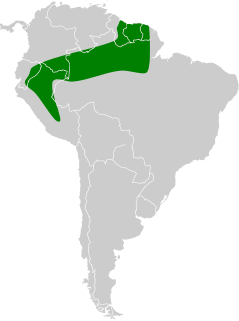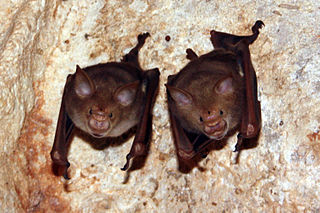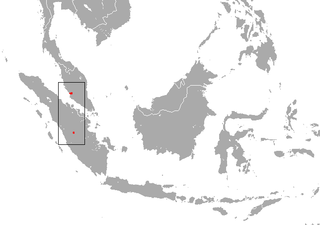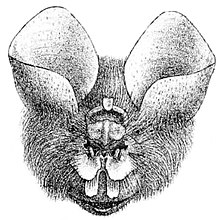
Brock's yellow-eared bat is a species of bat in the family Phyllostomidae, the leaf-nosed bats. It is native to South America, where it occurs in Brazil, Colombia, Guyana, Suriname, French Guiana, and Peru.
The Taiwan tube-nosed bat is a species of vesper bat in the family Vespertilionidae. It is found only in Taiwan. It is a close relative of Hutton's tube-nosed bat, and might even be the same species.

Coelops is a genus of bat in the family Hipposideridae. It contains the following species:

The Malayan tailless leaf-nosed bat is a species of bat in the family Hipposideridae. It is a very small bat which has long and soft fur. The fur coloration is brown to blackish on the dorsal surface and ashy on the ventral surface. It can be distinguished from the other roundleaf bats by its small size and the absence of the tail. It is listed as vulnerable by the IUCN

The Pomona roundleaf bat, Pomona leaf-nosed bat, or Andersen's leaf-nosed bat is a species of bat in the family Hipposideridae that is endemic to India.

Ridley's leaf-nosed bat, Ridley's roundleaf bat, or Singapore roundleaf horseshoe bat is a species of bat in the family Hipposideridae. It is found in Brunei, Malaysia and Singapore. Its natural habitat is subtropical or tropical swamps. It is threatened by habitat loss.

The Hipposideridae are a family of bats commonly known as the Old World leaf-nosed bats. While it has often been seen as a subfamily, Hipposiderinae, of the family Rhinolophidae, it is now more generally classified as its own family. Nevertheless, it is most closely related to Rhinolophidae within the suborder Yinpterochiroptera.

The orbiculus leaf-nosed bat, also known as the orbiculus roundleaf bat and small disc roundleaf bat, is a species of bat from the family Hipposideridae. The species has been found on the island of Sumatra in Indonesia and on peninsular Malaysia.
Griffin's leaf-nosed bat is a species of roundleaf bats. First seen in 2008, it was formally described in 2012. It is found only in Vietnam, and only at two places, Cát Bà Island in northern Vietnam, and Chư Mom Ray National Park. It is generally similar to the species complex of the great roundleaf bat, with which it shares the habitat, but has distinguishing characters. It is relatively smaller and its sound navigation, echolocation, is different.

The shield-nosed leaf-nosed bat or shield-nosed roundleaf bat is a bat from Laos and Vietnam.
Hipposideros alongensis, known as the Ha Long leaf-nosed bat, is a species of bat in the family Hipposideridae. It is endemic to Vietnam. It is listed as a vulnerable species by the IUCN.










